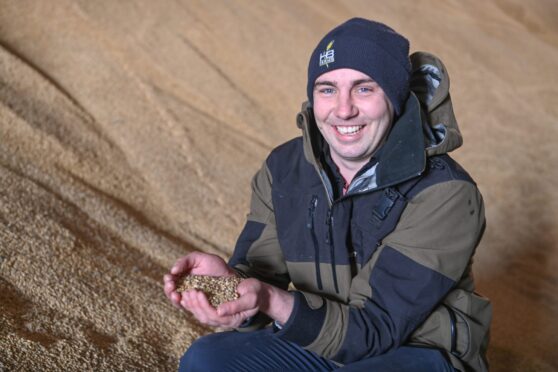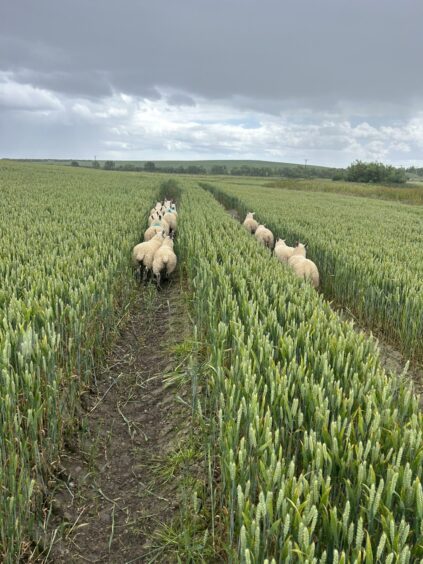I am writing this column when the north-east is currently in a yellow warning zone from the Met Office and it is too wet for me to venture over to the rain gauge to see how much water has fallen so far.
I’m sure the readers must get fed up with every farmer making an opening statement about how busy life has been, how the weather has hampered them but come on summer, where are you?
My usual work rain jacket is still currently hanging up wet from Sunday evening’s rain and I’m not even allowed the heating on to help dry it as it’s ‘summertime’.
It’s at this point just before harvest that we find out how our stock management of wheat, barley and oilseed rape has been through the year.
Crops looking well despite challenging weather
Our intention is to grow as much feed as possible, this along with buying additional grain locally means we are aiming at growing a 5-mile pig.
I’m pretty happy with most of our crops this year. Spring barley could be described as too thick in some fields – something I never believed I would be saying a couple of months ago.
Oilseed rape is starting to turn slowly and will be sprayed off in the month of July. Pod numbers and seed numbers seem good which hopefully bodes well.
Our wheat has good sized heads and plenty of them. Disease control has been tricky after a wet winter and some very heavy showers through the spraying season.
Oilseed rape to be sprayed off this month
Septoria is our main disease and this spreads up the plant by rain drops splashing and bouncing up the plant. Spray timings have been hard to get right with the catchy windy weather.
Although the crops look good, we have had very little sunlight so far this year – I’m sure that’s not a shock to anyone. My worry is that lack of sunlight might lead to smaller grains which reduces quality and yield.
My immediate worry is the winter barley and the risk of brackling in the coming weeks.
I would expect us to be combining the first crops in about three weeks’ time so heavy rain and wind is not ideal as the grain heads get heavier and straw becomes more brittle.
The one product we struggle to grow is soya meal or protein equivalent. We are experimenting with legumes and other sources of protein however getting a consistent product is difficult.
Combining fast approaching
Soya seems to be a dirty word, however it is key to the efficiency in our pig enterprise.
There is no doubt the UK would struggle without it. The meal we use to feed to pigs is a by-product, with the crop being grown for oil extraction first and foremost.
Last Tuesday I joined a visit as part of the NFUS Pig Working Group to visit the King Charles V Dock in Glasgow to meet one of the companies responsible for bringing some of the feeds and minerals we use into the country.
In the food industry, like many other industries, we are determined to improve what we do, ensuring we only import soya from non-rainforest areas or areas that could have been a rainforest in the last 20 years.
In fact more and more of the imports are coming from north America where farmers are being encouraged to grow the crop due to it being a legume and a very low carbon footprint.
I managed to get two days down at the Royal Highland Show this year, which as ever, was fantastic.
It’s 10 years since I was a student wandering around Ingliston trying to look like a farmer and pretending I would buy any shiny machine I came across.
Visit to Royal Highland Show a success
However now I find myself trying to not look too much like a farmer and actually doing business on some of the trade stands.
This year, we have spent a few months looking into buying a tractor. This meant a bit of testing different tractors on the farm and plenty of conversations with local dealerships about what they and their machines can offer.
I think the personal side is so important when it comes to making decisions on the next investment coming to the farm. The best thing for us was there were three very good machines and packages that we would have been happy to buy and it really came down to fine details and gut feeling in the end.
So, the final deal was done for a new tractor at the Highland Show where we could speak to our local dealership and the manufacturer at the same time. You could say it was a bit of a boyhood dream ticked off going to the show and actually buying a tractor.
New tractor and shed improvements
Shed improvements have been one of our tasks while we have some time before field work really takes up our time.
The focus being on storage sheds away from the farm to make sure we can get all our straw under cover quickly, keep machines dry and safe where ever possible and have spare grain tipping areas in case we have break downs over harvest.
Let’s hope for an Indian summer and everyone’s hard work pays off when the harvest season arrives. Stay safe!

